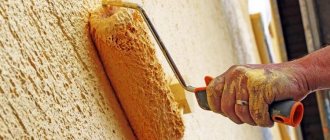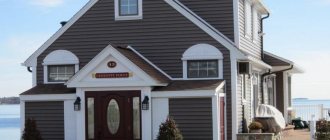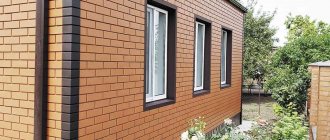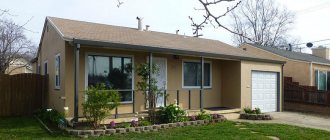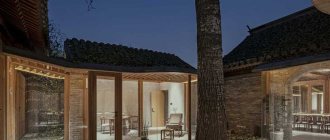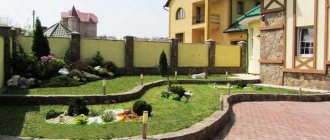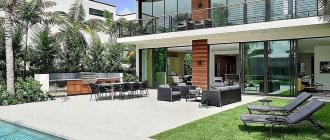Upon completion of construction work, everyone wants their home to be attractive not only inside, but also outside. To decorate the facade of a private house, various materials are used, one of which is plaster. Plastering the facade is an aesthetically attractive finishing option that allows you to protect the walls of the house from atmospheric influences. At the same time, it is important to choose the right type of plaster, since working with it has its own subtleties and nuances.
Types of facade plasters
Decorative components in the composition of the material indicate its group:
A uniform dough-like mass constitutes a texture group. Color may vary depending on color scheme. It is added to the mixture or during the process of painting the facade surface.
Thanks to its high plasticity, real masterpieces are created on the walls - exquisite and artistic. The fact is that the composition contains natural fibers from cotton, flax and even... ground brick.
In the photos of façade finishing with plaster presented on the Internet, you can find many original compositions. They have unusual bright names “American”, “Venetian” and “Popcorn”.
A heterogeneous mass with granular inclusions is a structural group. The main component is a binder. To work, it is diluted either with water or a special solvent.
This facade decor is called, respectively, “Fur Fur”, “Lamb” or “Bark Beetle”. The decorated façade with bark beetle plaster is of the greatest interest to many home owners.
Key Features
The choice of plaster mixture for cladding the facade of a private house usually falls on the architect, since he can correctly select the type of material and its color scheme, calculate the amount of plaster, taking into account its features and technical properties. Moreover, all types of plaster that are used for exterior decoration of a house have common features, namely:
- They create a durable and “breathable” coating, which prevents condensation from forming underneath.
- Excellent resistance to ultraviolet rays, temperature changes and moisture.
- Good adhesion to various substrates.
- High elasticity.
- Environmentally friendly.
- High speed of finishing work.
- Attractive appearance.
- Easy maintenance and long service life.
- The plaster contains substances that enhance the thermal insulation properties of the coating.
Cost of façade finishing work
The plaster of the façade is assessed depending on the number of decorative components and the height of the building itself. For example, the price of finishing a façade with “Bark Beetle” plaster, together with wall insulation work, costs on average one and a half thousand rubles per square meter.
Pros and cons of facade plaster
pros
- The application method is very simple. A person without certain skills will be able to cope with such work on his own;
- environmental cleanliness;
- texture, colors, application methods are very different;
- aesthetics and quality;
- resistance to strong external influences and durability;
- unpretentious operation.
Minuses
- complete finishing takes significantly more time and energy consumption - the reason for hiring special teams;
- does not last as long as clinker, brick, ventilated facades;
- the material is selected more carefully depending on the surface and material of the walls;
- if workers do not follow the technology, the plaster will not last so long, and the main wall, for example made of aerated concrete, may partially collapse.
How to select and combine colors on the facade
The color of the outer covering is determined by the style of construction and the wishes of the customer. When selecting, they take into account the color scheme of window frames, doors, roofs, the shape of the walls, national traditions, and the purpose of the building. The most common finishing option is the white facade of the house with plaster. It is perfect for a building for any purpose; if necessary, it can be easily tinted, does not require complex coloring, and such a structure looks aesthetically pleasing and presentable.
For a private home, light shades are selected that harmoniously highlight the details of the structure and evoke warm emotions. Office buildings and government institutions are painted either in neutral, bright, noticeable colors: gray, red, light brown, yellow.
To correctly guess the color of a building, you can use expert advice:
- Simple architectural forms accept rich shades. Complex, with an abundance of columns, bay windows, winding and stepped structures - will look advantageous in a pastel, light color palette;
- No more than 2-4 colors are used in decoration so that the building looks organic and fits into the general appearance of the area;
- You can emphasize the color feature of the house with the help of textured finishes. A smooth surface enhances the perception of color, making the façade more noticeable and brighter. Relief, volumetric finishing mutes the color of the walls;
- Saturated shades quickly fade in the sun, dark colors increase the intensity of heating of the building;
- Using different shades you can visually hide design flaws;
- The roof and base are traditionally painted in darker colors, the walls in light colors;
- Natural, soft colors are perceived better than bright, too intense ones.
A house built according to a standard or individual design can be beautifully decorated, and at the same time insulated and protected using inexpensive materials. Making a modern, presentable, cozy home is not difficult. A wide selection of ready-made structures will serve as a guide.
